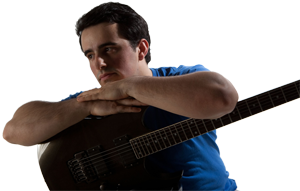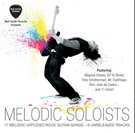How Scales Can Help You Become A Better Guitar Player
 Most guitar players feel like they are treading water in an endless collection of exercises, books, DVDs and other resources for learning to play guitar. It seems ironic that although in today’s world we have access to more guitar learning materials than ever, the process of improving your guitar playing hasn’t become substantially easier. If I just described you, you are definitely not the only one who has faced such a challenge.
Most guitar players feel like they are treading water in an endless collection of exercises, books, DVDs and other resources for learning to play guitar. It seems ironic that although in today’s world we have access to more guitar learning materials than ever, the process of improving your guitar playing hasn’t become substantially easier. If I just described you, you are definitely not the only one who has faced such a challenge.
Ironically, most people who share this problem try to deal with it by taking a totally wrong approach. By believing that their slow progress on guitar is due to poor exercise selection, they begin to search for even more new guitar learning materials. However, because little or no effort is put into learning the best way to actually practice these exercises, the practice time spent on them brings zero results.
The reality is that instead of constantly seeking to discover additional new exercises, you should learn how to get the most from the guitar materials you ALREADY have (which, if you have played guitar for any length of time, is “more than enough”). When you learn how to maximize the improvement in your guitar playing from working only on a single practice item, several things will happen:
1. You will progress more quickly due to not having to practice so many guitar exercises to get to the next level in your playing.
2. When you truly need to, you will know exactly how to create your own exercises to address the exact issues you need to solve in your guitar playing.
The Exercises You Work On Mean Nothing Unless You Understand HOW To Practice Them
When you practice guitar, you must be able to clearly explain (at least to yourself) the reasons why you are working on a particular practice item at any given time. Being able to give such an explanation helps to keep your practicing directed in a specific path, instead of letting it become a random and unfocused waste of time.
To explain more clearly what I mean, consider a very common example of practicing scales on guitar (something that all guitar players have done at one point or another). Although virtually everyone understands that scales are an important item to practice for musicians, few guitar players consciously know how to direct their practicing of scales to help them improve the following specific areas of their musicianship:
1. Learning to play guitar fast
2. Learning to improvise guitar solos (or improving their ability to do so)
3. Visualizing the guitar neck completely
4. Expanding their creativity in music
A specific list of actions is needed to help you achieve each of the above objectives. To make that happen, your mind needs to act as a compass to direct your hands to take the appropriate steps during each practice session dedicated to scales. When doing this, it is necessary to set specific miniature objectives for every individual practice session. To avoid any misunderstanding, these “miniature objectives” are NOT the same thing as the big, long-term vision you want to reach as a guitar player (several years from now). Instead (as described above), they are similar to a map and a compass that tells you exactly how to move (what actions to take) to reach a very small specific goal. When you become comfortable doing this, you will see that it is very possible to get better in many elements of your musicianship with only one guitar practice item. However since most guitar players do not have this mindset while practicing, their practice sessions often turn into little more than a mindless list of items to play through, with no understanding of how each exercise is (or should be) bringing them closer to their goals. This alone accounts for a huge portion of the reason why most musicians never realize their guitar playing potential.
The skill of being able to set individual goals for each item in every guitar practice session does not come intuitively to most people and this is also why studying guitar on your own is a poor choice for many musicians. However, regardless of whether you take guitar lessons or not, by making an effort to go through the above process in your practicing will already improve the results you get in your guitar playing.
To illustrate the above process in action, I will describe a few examples of how it is possible to use a common guitar practice exercise such as scales to grow as a guitar player in a variety of areas. As explained earlier, this will be achieved by focusing your mind on a specific list of objectives in every practice routine.
Using Guitar Scales To Refine Guitar Technique
If you practice scales, trying to refine your physical guitar playing, you must consciously focus your mind on each element of great technique in turn: minimizing extra tension, avoiding excessive hand/finger motions, picking articulation and the ability of both hands to work in sync. To see how this is done, watch this free video lesson about picking technique on guitar. The main thing I want you to understand here is the critical distinction between working on scales specifically to improve in one of the elements above as opposed to robotically moving your fingers through dull sets of fingering patterns that most guitar players do. Understanding and applying this difference is what it takes to more effectively train your hands for better guitar playing with scales.
Using Guitar Scales To Become A Better Improviser
Among the many things you need to practice to learn to improvise on guitar, one of the things you must become proficient in is the ability to play scales all over the guitar accurately and easily. To specifically practice this skill, one of the things you should do is work on each scale position for several minutes at a time, coming up with licks and phrases from it, while temporarily restricting yourself from using any of the other shapes of the same scale. After a few minutes of practicing in this way, move to another shape of the scale and repeat the process. Obviously this is not the only way you should practice scales to learn to improvise guitar solos (I can show you many more ways in my course about rock guitar scales), but the main thing to understand here is how your focus is different when practicing scales to improve your improvising in contrast to working on scales to progress in some other element of your musicianship.
How Practicing Scales On Guitar Helps You Learn The Guitar Neck Better
When you work on learning the guitar neck with scales, you need to pay more attention to how the scale shapes form visual patterns that occur all over the fretboard. In this case, less attention is needed to be paid to what your hands are doing and all efforts must be directed on memorizing how every scale pattern will look in your mind before your hands touch the guitar. When you focus in this way, it will be impossible for your fingers to mindlessly go through the motions of practicing and your fretboard visualization skills will have no choice but to improve. To see how you should practice this, study this free video lesson on learning the neck of the guitar.
How Practicing Scales On Guitar Will Make You A More Creative Musician
One effective way to become a more creative guitar player when practicing scales is to work on coming up with new sequences and phrases from scale shapes that you are practicing. Instead of merely playing the notes of the scale up and down in a boring way, this will require your mind to think in innovative ways that you don’t normally do when doing regular guitar practicing. This is yet another way of how scales can be used to grow a certain element of your musical skills by directing your attention to a very specific mini goal.
Now that you understand more about how to use a single guitar practice exercise to expand your musical skills, it is important to mention 2 other critical points:
1. Of course, in addition to scales you can easily take any guitar exercise in existence and by using some creative thinking you can practice it to improve EVERY aspect of your musicianship.
2. With all of this being said, I do not want you to think that having lots of exercises to practice on guitar is a bad thing. On the contrary, having a variety of guitar practice items can be quite helpful, BUT it is critical to know how to use any single exercise you practice in order to improve MANY different elements of musicianship.
To help you apply the advice from this article, I recommend to break up working on each mini goal in your guitar playing during a different day of the week. As an illustration, you can focus on improving your guitar playing creativity with scales on Wednesday, followed by practicing scales to learn the guitar fretboard on Thursday and so on. This will help you to focus better on each specific objective and improve your guitar playing faster as a result.
Begin applying this method of practicing guitar for each and every exercise you practice and you will shock yourself by how much faster your guitar playing will start to improve. The more you apply this philosophy to your practice sessions, the faster you will achieve the level of guitar playing that you have always dreamed about.
If you haven’t yet checked out the resources mentioned throughout this article, I recommend to do so now:
Video on learning the neck of the guitar
Video eCourse about rock guitar scales
About the author:
Mike Philippov is a guitar teacher and professional musician. His lessons and writings about the process of practicing guitar are read by guitar players around the world. Go to http://PracticeGuitarNow.com to find a collection of free guitar learning materials that will help you to become a more advanced musician and guitar player.










